The Intel Skylake-X Review: Core i9 7900X, i7 7820X and i7 7800X Tested
by Ian Cutress on June 19, 2017 9:01 AM ESTBenchmarking Performance: CPU System Tests
Our first set of tests is our general system tests. These set of tests are meant to emulate more about what people usually do on a system, like opening large files or processing small stacks of data. This is a bit different to our office testing, which uses more industry standard benchmarks, and a few of the benchmarks here are relatively new and different.
PDF Opening
First up is a self-penned test using a monstrous PDF we once received in advance of attending an event. While the PDF was only a single page, it had so many high-quality layers embedded it was taking north of 15 seconds to open and to gain control on the mid-range notebook I was using at the time. This put it as a great candidate for our 'let's open an obnoxious PDF' test. Here we use Adobe Reader DC, and disable all the update functionality within. The benchmark sets the screen to 1080p, opens the PDF to in fit-to-screen mode, and measures the time from sending the command to open the PDF until it is fully displayed and the user can take control of the software again. The test is repeated ten times, and the average time taken. Results are in milliseconds.
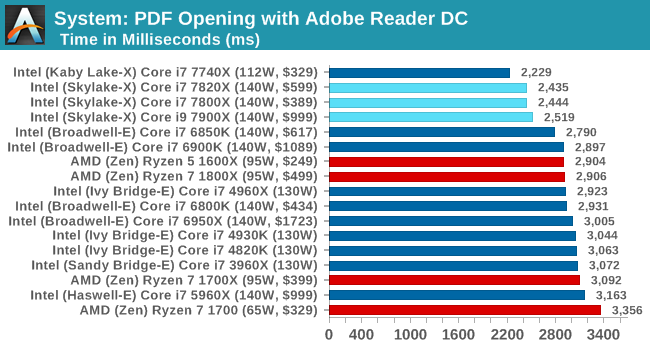
The extra frequency of the new processors is helping when it comes to opening our monster PDF, but also the extra L2 cache is likely having an effect as well.
FCAT Processing
One of the more interesting workloads that has crossed our desks in recent quarters is FCAT - the tool we use to measure stuttering in gaming due to dropped or runt frames. The FCAT process requires enabling a color-based overlay onto a game, recording the gameplay, and then parsing the video file through the analysis software. The software is mostly single-threaded, however because the video is basically in a raw format, the file size is large and requires moving a lot of data around. For our test, we take a 90-second clip of the Rise of the Tomb Raider benchmark running on a GTX 980 Ti at 1440p, which comes in around 21 GB, and measure the time it takes to process through the visual analysis tool.
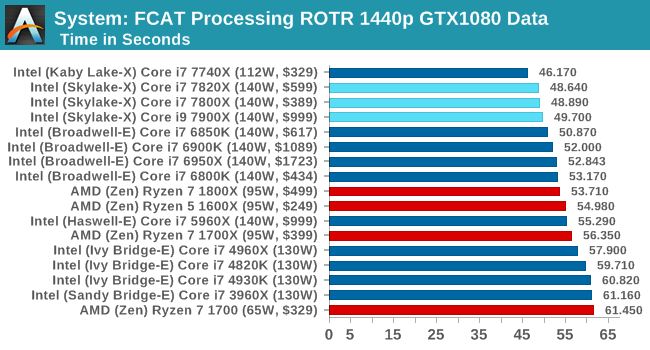
FCAT takes in a frame, processes it and dumps it, all on a single thread. The quicker you get through the workload the better, and frequency is supreme, hence we get the 7820X followed by the 7800X then the 7900X. Even though the 7900X has the higher turbo here, the results are with the margin expected.
3D Particle Movement v2.1
This is the latest version of the self-penned 3DPM benchmark. The goal of 3DPM is to simulate semi-optimized scientific algorithms taken directly from my doctorate thesis. Version 2.1 improves over 2.0 by passing the main particle structs by reference rather than by value, and decreasing the amount of double->float->double recasts the compiler was adding in. It affords a ~25% speed-up over v2.0, which means new data.
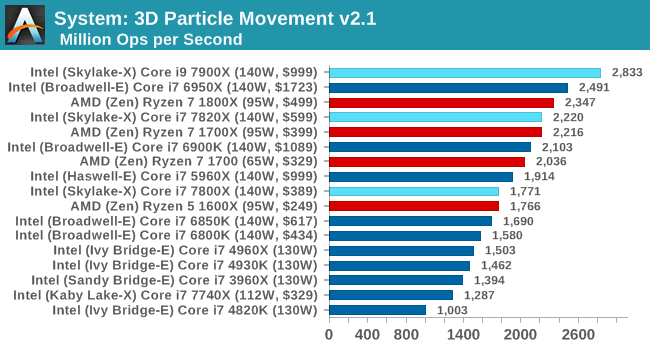
Give 3DPMv2.1 some cores, and it will show you the world / some numbers. The 1800X and 6950X were gunning for top spot, but the extra frequency of the 7900X wins here.
DigiCortex 1.20
Despite being a couple of years old, the DigiCortex software is a pet project for the visualization of neuron and synapse activity in the brain. The software comes with a variety of benchmark modes, and we take the small benchmark which runs a 32k neuron/1.8B synapse simulation. The results on the output are given as a fraction of whether the system can simulate in real-time, so anything above a value of one is suitable for real-time work. The benchmark offers a 'no firing synapse' mode, which in essence detects DRAM and bus speed, however we take the firing mode which adds CPU work with every firing.
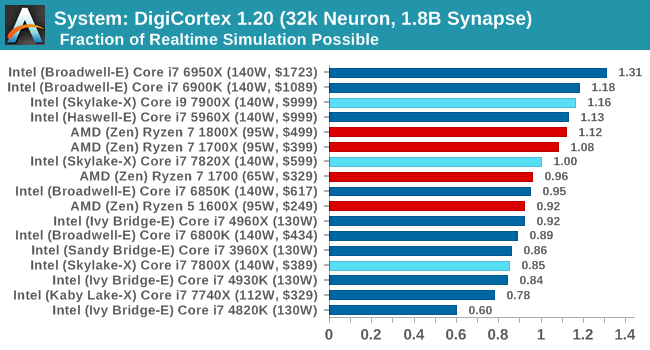
DigiCortex loves a bit of memory, although when speaking with the developer, there can some instances where the beast needs to be fed. Losing the inclusive L3 might be a factor here, especially with the 7800X all the way down.
Agisoft Photoscan 1.0
Photoscan stays in our benchmark suite from the previous version, however now we are running on Windows 10 so features such as Speed Shift on the latest processors come into play. The concept of Photoscan is translating many 2D images into a 3D model - so the more detailed the images, and the more you have, the better the model. The algorithm has four stages, some single threaded and some multi-threaded, along with some cache/memory dependency in there as well. For some of the more variable threaded workload, features such as Speed Shift and XFR will be able to take advantage of CPU stalls or downtime, giving sizeable speedups on newer microarchitectures.
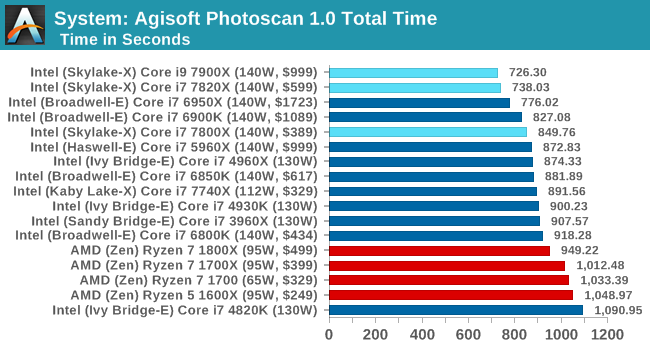
Photoscan is a mixed bag of operations, going through single thread sections to multithread and a range of cache/memory bandwidth requirepements. There's not much difference between thw 10 core and the 8 core, but the frequency helps against Broadwell-E.










264 Comments
View All Comments
Ian Cutress - Monday, June 19, 2017 - link
Thanks!Cellar Door - Monday, June 19, 2017 - link
Good review Ian! But you would agree that this launch feel very 'half-baked'?I don't think there ever was an Intel launch with this many issues on the platform at start.
Ryan Smith - Monday, June 19, 2017 - link
"I don't think there ever was an Intel launch with this many issues on the platform at start."Intel always rolls out some new technology on their HEDT processors, which usually invokes teething issues. X99/HSW-E was the first DDR4 platform, and X79/SNB-E launched with some pretty gnarly PCIe 3.0 issues. So X299/SKL-X is fairly similar to past launches, for better or worse.
Drumsticks - Monday, June 19, 2017 - link
Still working my way through some of the review, but: "The latest KNL chips use 72 Pentium-class" on the microarchitecture analysis page is wrong. Knights Corner was derived from a Pentium but KNL is derived from Silvermont.Ryan Smith - Monday, June 19, 2017 - link
Thanks!Drumsticks - Monday, June 19, 2017 - link
Just finished. Thanks for the review. I look forward to seeing updated gaming benchmarks. Would have loved to see what you had similar to Kaby Lake X showing up here and there, but I understand not wanting to show incomplete data. I trust the editorial integrity of Anandtech more than the comment section, so I'm not crying foul. Can't wait for the follow up!Ian Cutress - Monday, June 19, 2017 - link
Some Kaby-X data is in Bench, mostly the CPU stuff. I need to replace my Kaby i7 that failed.Drumsticks - Monday, June 19, 2017 - link
Will take a look then, thank you!Vanquished - Monday, June 19, 2017 - link
Never visiting your site again. You make excuses for Skylake-X crappy gaming performance but were more than happy to bash AMD for the same issue.What a load of crap, shame on you.
Slappi2 - Monday, June 19, 2017 - link
Wow. RageQuit because you don't like the truth. It's a CPU!